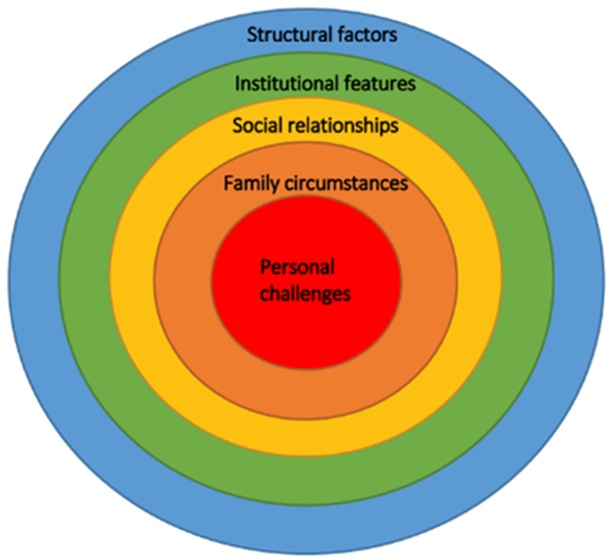Frameworks: Tackling NEET
Our two frameworks support effective identification and intervention.
RISK FRAMEWORK: Access a more holistic and nuanced understanding of the risk factors leading to an increased likelihood of NEET outcomes and early school leaving.
INTERVENTION FRAMEWORK: Understand the five key mechanisms underpinning effective interventions to tackle NEET outcomes and early school leaving; The Pathway To Change.
Risk Framework
“The risk model has been really useful, it's helped us to understand the risks that play a part in the outcomes for young people who are NEET or at risk of NEET.”
Katie Cross, Partnerships and Business Development Lead, Wiltshire Council
“This has enabled us to have a much more effective new RONI tool.”
Richard Lucas, Transition College Head, Somerset Works
Video with subtitles available here.
This model organises the multiple risks into five categories. It is the most comprehensive model of risks to NEET and early school leaving currently available. It supports professionals to consider:
- multiple risks in a manageable and systematic way
- how risks in one category influence risks in another category
- which categories of risk the young person sees as a priority for support
- where to start in supporting young people to unpick complex challenges

Select a heading to show more detail about the risks within that category.
Risks relating to health and abilities (SEND, Autism, mental health challenges); emotions or self-concept (low self-esteem, low aspiration, motivation or expectation, fear of failure, anxiety); significant experiences (irregular transitions, abuse, neglect, trauma, isolation) behavioural (absenteeism, communication difficulties, difficulties trusting others, disengagement, exclusion, youth offending) and identity-related issues (Gender-identity, experiences of discrimination).
Material circumstances (low income, caring responsibilities); cultural factors (family aspirations or value of education); social circumstances in the family (family relationships, parenting challenges); physical, mental and emotional needs and availability of family members. Highly mobile or turbulent lives.
Challenging relationship issues with adults and peers (outside of the family) (e.g. strained relationships with teachers or employers, friendship difficulties, experiences of bullying, isolation, social skill development need)
Institutional Features of the School or work place, such as the environment (e.g. large class sizes, non-inclusive classroom layouts, lack of safe spaces); School policies (e.g. poor-quality behaviour management and wellbeing systems, exclusion and attendance policies); social regulatory expectations (e.g. institutional rigidity, relegated to work in corridors); level of support available (e.g. limited teacher time, lack of career guidance); school culture or climate (e.g. inclusive or exclusionary values, exam pressure, performance expectations)
External societal influences that operate outside of,- but can affect,- the young person’s daily experiences e.g. economic challenges like cuts to services, LAs, regional infrastructure and transport services; the impact of national policies around education and work e.g. raising participation age, changes to grading systems, requirement for Post16 Literacy and Maths, resourcing for tracking mechanisms; performance targets and benchmark standards, funding approaches for FE.
Intervention Framework
“The Pathway To Change has impacted our casework processes enormously. It's helped us reconsider the whole design of the process.”
Deanne Mahoney, Assistant Head of Partnership College, Somerset Works
“The beauty of the videos is the way they communicate, very simply and powerfully, in-depth research findings. It makes the insights accessible to professionals.”
Katie Cross, Partnerships and Business Development Lead, Wiltshire Council
Video with subtitles available here.
The toolkit's intervention resources are based on an evidence-informed theory of change: The Pathway to Change. Supporting young people along this pathway from disengagement to (re)engagement involves five key mechanisms.
Knowing where students are on the pathway allows you to tailor the content, nature and duration of interventions appropriately. It also offers a framework for evaluating progression and intervention impact.

Select a heading to show more detail about the mechanisms.
These first two mechanisms are important to initiate at the outset of working with the young person and act as a foundation for meaningful change.
Supporting emotional wellbeing and general welfare involve addressing the most pressing needs that at-risk of NEET young people present with. If the young person is in emotional or physical distress, they may be unable to think beyond these immediate needs.
Addressing the barriers that impact young people’s sense of wellbeing and welfare helps to generate a sense of feeling cared for, understood and supported. This mechanism is essential to the building of trust between the young person and the educator, so that the young person’s self-concept and view of the social world can improve.
Research shows that simply providing support is not enough to lead to change. Young people must feel that sense of support, and that it is unpinned by the educator’s care and concern for them and leads to a sense of feeling known and understood.
The third mechanism is enabled by an established and trusting relationship between the educator and young person. It can also be strengthened by positive relationships with peers and other adults in the young person’s daily life. Building confidence and self-esteem is important in tackling early school leaving and NEEThood as confidence builds hope, leading to a positive view of their contribution to school/ work and the local community.
The fourth mechanism involves facilitating a sense of ownership and autonomy over learning and achievement. This is best achieved once the young person’s confidence and self-esteem has been built. It is essential to any strategy tackling early leaving and NEEThood because it involves young people believing that a positive future is possible for them and involves the development of positive aspirations regarding education and work.
Building a positive learner identity is a higher-level mechanism as it concerns young people’s sense of fitting in to their educational and work settings. It also involves young people’s belief in their contribution to wider society and the feeling that education, training or work is within their reach.
